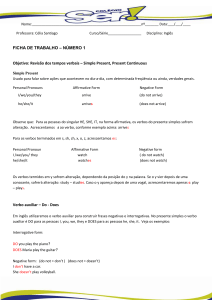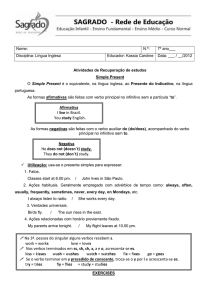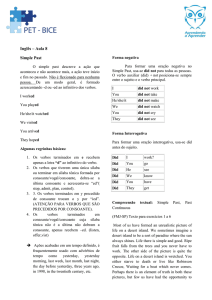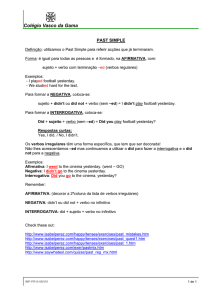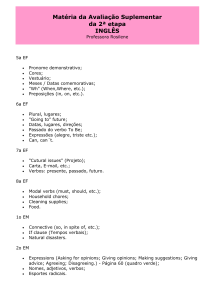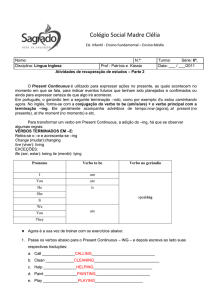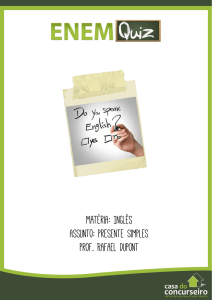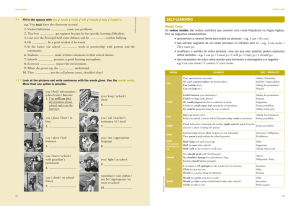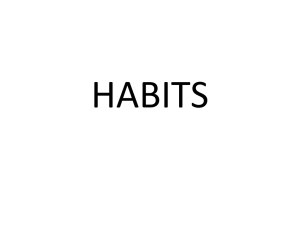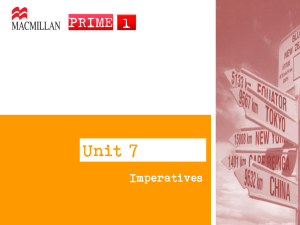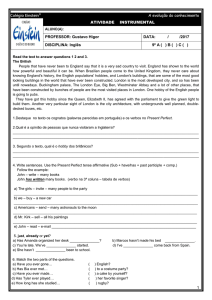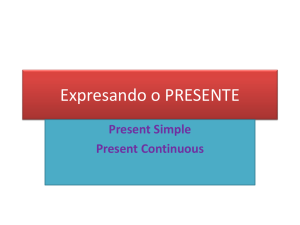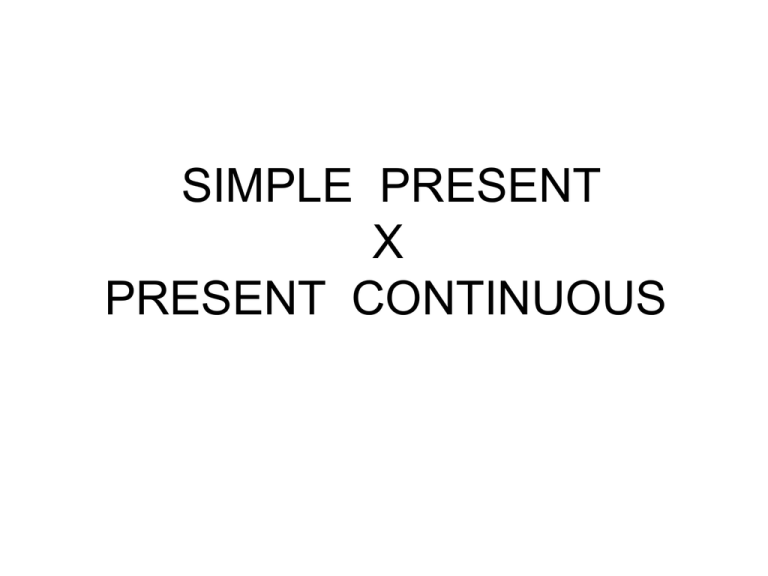
SIMPLE PRESENT
X
PRESENT CONTINUOUS
SIMPLE PRESENT
• É usado para expressar, principalmente,
ações habituais e afirmações universais.
• Usualmente é acompanhado de um
advérbio de frequência.(usually, always,
every day, often, frequently,...)
• Usa-se os auxiliares Do, Don’t (I, You, We,
They), Does, Doesn’t (He, She, It)para as
formas interrogativa e negativa e também
para respostas curtas.
• Ex.:
A: I like apples, and you? Do you like
apples?
B: Yes, I do./ No, I don’t.
A: What about her? Does she like apples?
B: Yes, she does. / No, she doesn’t.
• Ex.:
A: Does Karla study in the morning?
B: Yes, she does. But my older brothers
study at night.
A: Oh, really? In which school do they
study?
B: They study at Externato’s School.
REGRA GERAL DE VERBOS
HE / SHE / IT
• Acrescenta-se -s aos verbos nas frases
afirmativas.
• Ex.:
We like pears. > He likes pears.
I get up early every day. > She gets up early.
You live in S. Paulo. > He lives in S. Paulo.
They drink water.> She drinks water.
Porém:
I have a car. > He has a car.
REGRAS DE VERBOS PARA
HE / SHE / IT
• Se a forma básica do verbo terminar em
o , ch , sh, x, ss, z
acrescenta-se -es
Ex.:
I do the homework.> He does the homework.
We watch TV.> She watches TV.
I wash my hair.> She washes her hair.
You mix the vegetables.> He mixes them.
• Se a forma básica do verbo terminar em
-y com consoante,
muda-se o –y para i e acrescenta-se –es.
Ex.: I study English on Mondays and
Peter studies English on Tuesdays.
I usually fry my steak and she fries hers.
Porém: nas frases negativas com doesn’t
os verbos voltam as suas formas básicas.
I don’t like apples. > She doesn’t like
apples.
PRESENT CONTINUOUS
• É usado principalmente para expressar ações que
estão acontecendo no momento presente. Em geral,
vem acompanhado de advérbios e locuções
adverbiais de tempo, tais como: now, at the moment,
at present, que ficam geralmente no final da oração.
• É formado com o presente do verbo be ( am/’m;
is/’s; are/’re) seguido da forma -ing do verbo
principal.
Ex.: Mathew is studying in his room now.
They are playing soccer at the moment.
I am listening to music now.
Atenção:
• Verbos oxítonos ou monossílabos tônicos
terminados em C – V – C, dobra-se a última
consoante.
Control >> controlling
Admit >> admitting
Swim >> swimming
• Verbos terminados em –e,elimina-se o –e
Arrive >> arriving
• Verbos em –ie, troca-se por –ying.
Lie >>lying
Fill in the gaps using the Simple Present.
1- We _______ (live) near the school.
2 – He _______ (go) to school by car.
3 – I ________ (play) volleyball every day.
4 – The dog _______ (drink) much water.
5 – She ________ (kiss) her mom .
6 – My brother ______ (have) a bike.
7 – I _______ (wash) my hair in the
morning.
Fill in the gaps using the Present Continuous.
1 – The children _________ (play) in the park
at the moment.
2 – Don’t go out! It __________(rain)
3 – My parents ___________(spend) some
days in Rio this week.
4 – Jeremy _________ (go) to Bahia by plane
next Monday.
5 – Tom and Liz ________ (come) to my party
tomorrow.
6 – I’m sure he __________ (lie) now.

